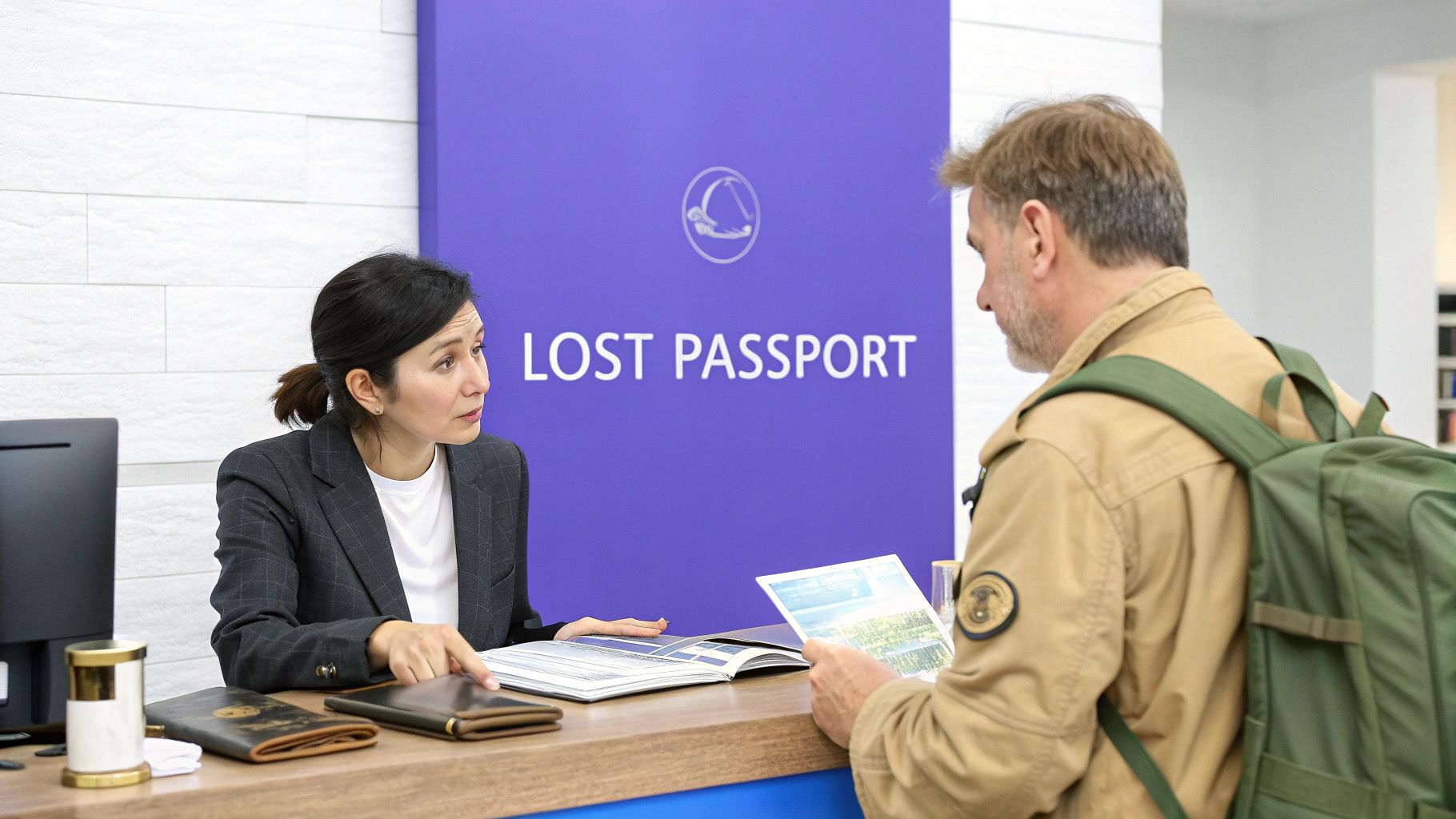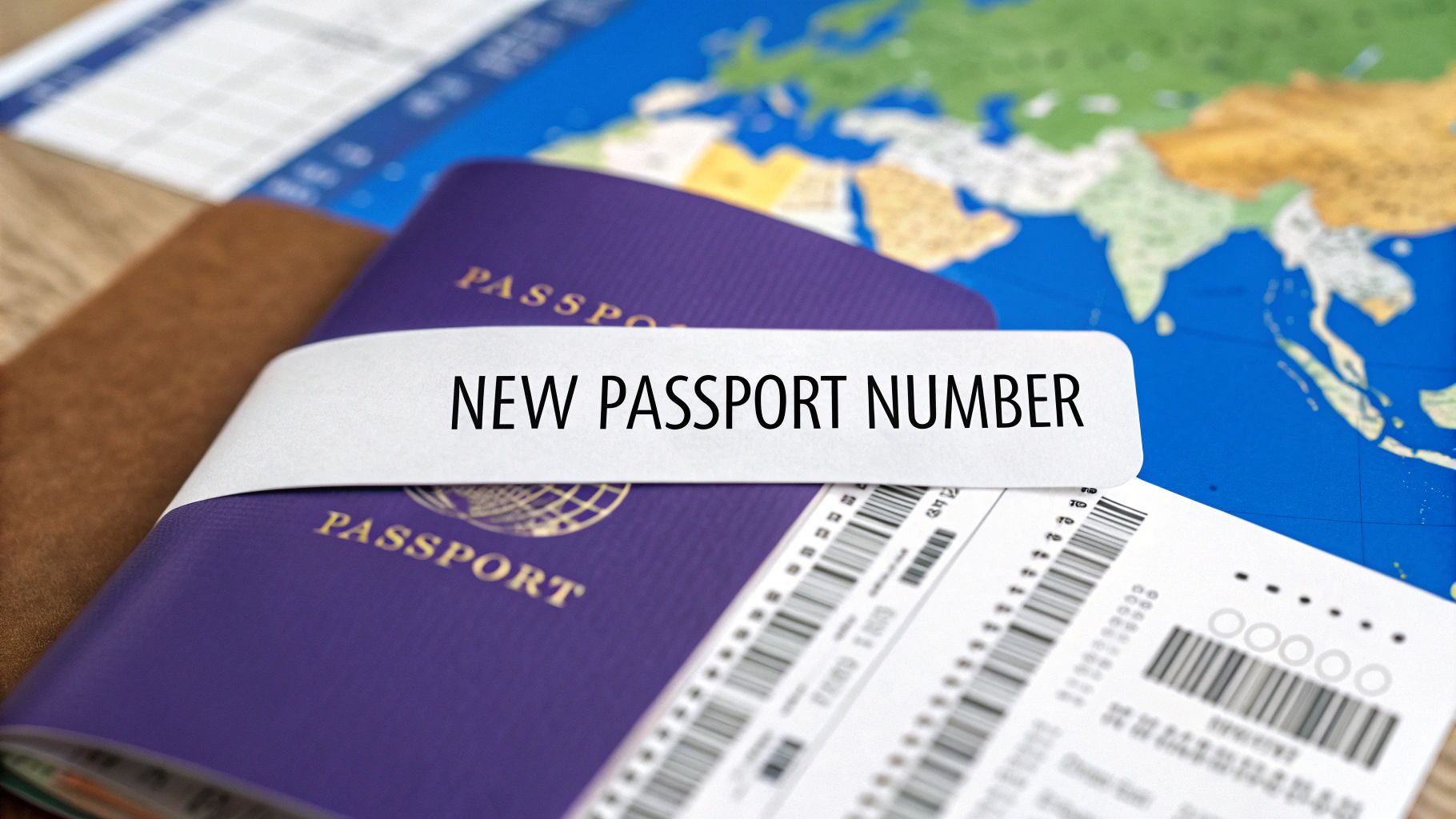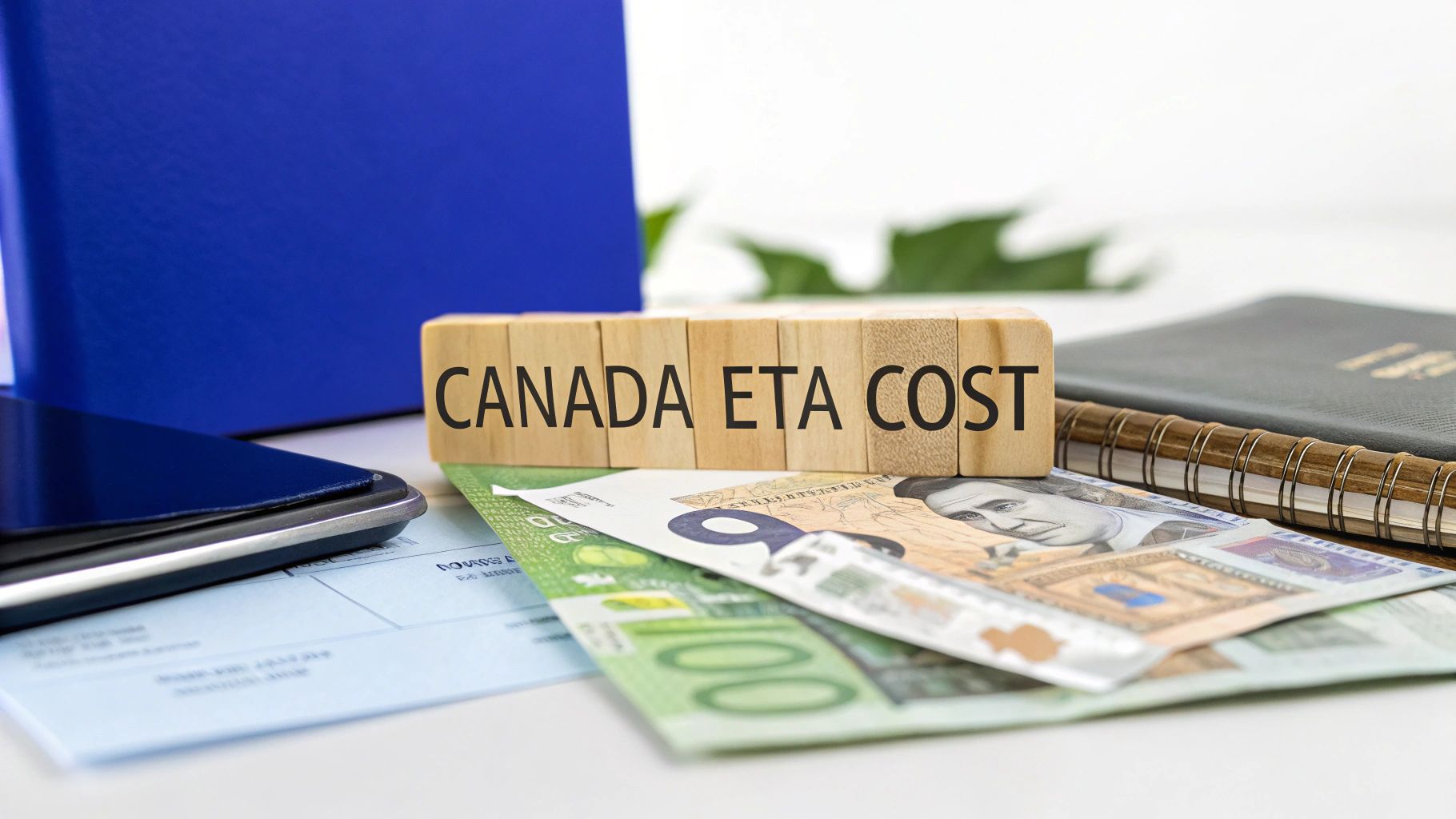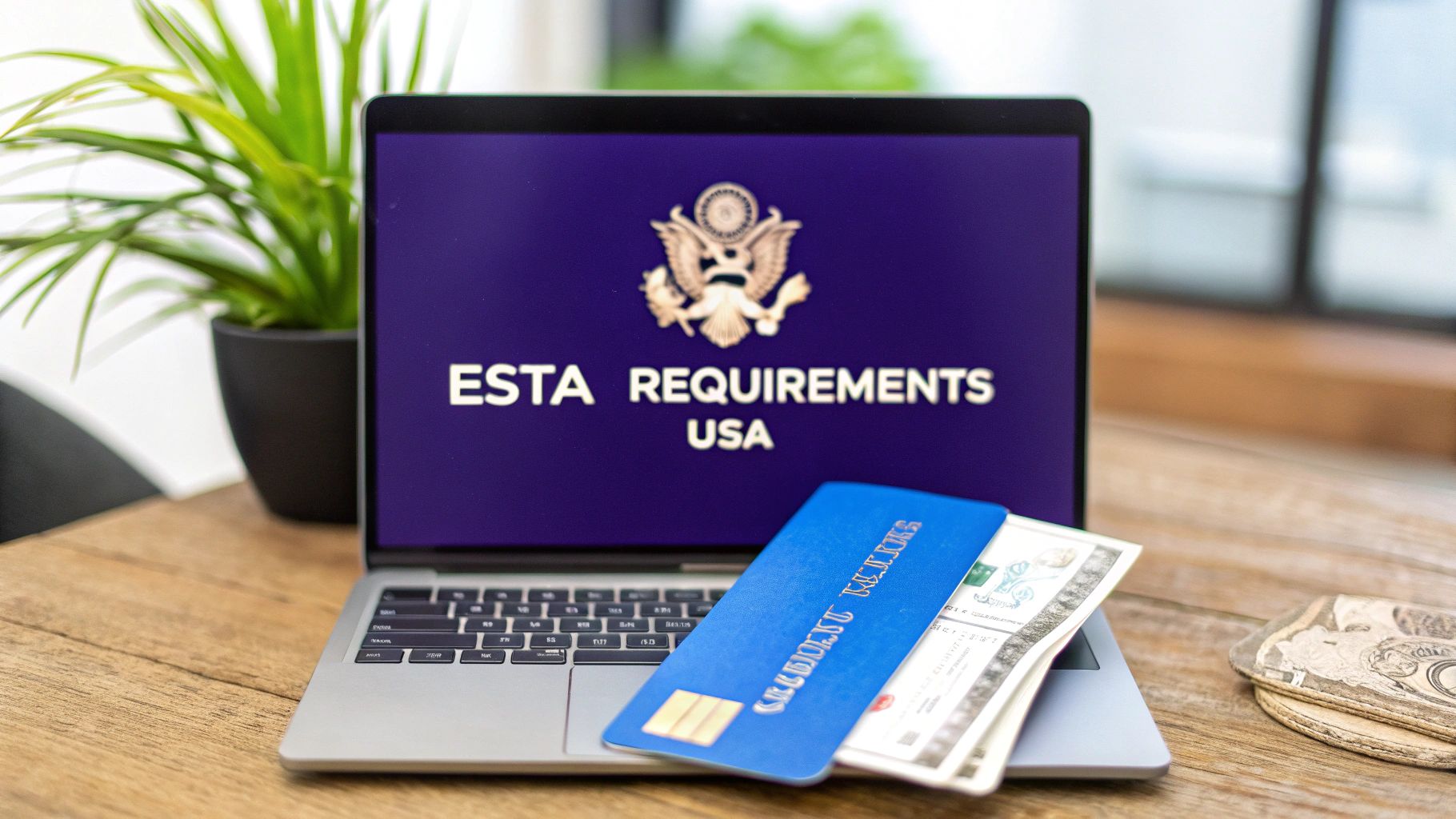
The Ultimate Guide to Getting Your US ESTA
So, what exactly is an ESTA? You can think of it as a mandatory digital hall pass for visiting the United States.
It stands for the Electronic System for Travel Authorization, and if you're from a Visa Waiver Program (VWP) country, you’ll need one to travel to the U.S. for tourism or business. An ESTA allows you to stay for up to 90 days at a time without needing to go through the lengthy process of getting a traditional visa.
What Is an ESTA and How Does It Work?

Simply put, the ESTA is a digital green light for your trip. Before you even book your flight, this system does a quick background check to make sure you don't pose a security risk. It’s a simple but crucial first step for millions of people, making international travel a whole lot smoother and more secure.
The whole point of the ESTA program was to beef up security while making it easier for visitors from trusted partner countries to come to the U.S. Once your application is approved, the authorization is electronically linked directly to your passport. That means when you check in for your flight or arrive at a U.S. border, the airline staff and Customs and Border Protection (CBP) officers can see your approved status instantly.
The Role of ESTA in Modern Travel
The United States was a real trailblazer here. The ESTA system, launched back in 2008, was one of the first major electronic travel authorizations in the world. It essentially created the blueprint that many other countries now follow for digital border control.
The numbers speak for themselves. By November 2023, the system had already processed over 90 million applications, with an impressive approval rate of more than 97%.
An approved ESTA is an absolute must-have for eligible travelers planning short trips. And if you're looking for inspiration, you can find some fantastic travel experiences in the United States to get your itinerary started.
Key Functions of the ESTA System
The ESTA isn't just a box-ticking exercise; it serves a few vital purposes that help both travelers and U.S. authorities. It gets rid of the old, clunky visa paperwork and replaces it with a fast online form.
Here’s a quick look at what the ESTA system is doing behind the scenes:
- Pre-Screens Travelers: It checks if you’re eligible to enter the U.S. under the VWP before you even get on a plane or ship.
- Enhances Security: It runs your information against various security and law enforcement databases to flag individuals who might pose a threat.
- Facilitates Legitimate Travel: It makes the journey much simpler for tourists and business travelers on short trips, which is great for international commerce and tourism.
This pre-screening is a critical layer of modern security. It helps identify potential issues long before a traveler ever sets foot on U.S. soil.
ESTA vs. A Traditional US Visa
It's really important to know that an ESTA is not a visa. Mixing these two up is a common mistake and can cause major headaches and ruin your travel plans.
To make this crystal clear, here’s a simple breakdown of the main differences.
ESTA vs US Visa Quick Comparison
| Feature | ESTA (Visa Waiver Program) | US Visitor Visa (e.g., B1/B2) |
|---|---|---|
| Purpose | Short-term tourism, business, or transit (up to 90 days) | Longer stays, tourism, business, medical treatment |
| Eligibility | Citizens of 42 designated Visa Waiver Program countries | Citizens of non-VWP countries or those ineligible for ESTA |
| Application | Simple online form, takes about 20 minutes | In-person embassy interview, extensive paperwork |
| Approval Time | Usually within minutes, up to 72 hours | Weeks or even months |
| Validity | Valid for 2 years or until your passport expires | Typically valid for up to 10 years |
The bottom line is simple: an ESTA is for quick, easy visits if you’re from a VWP country. A visa is for everything else, including longer stays, work, or study. Make sure you have all your travel documents sorted with our guide on how to prepare for international travel.
An ESTA does not guarantee entry into the United States. It only authorizes a traveler to board a carrier to the U.S. The final decision rests with the U.S. Customs and Border Protection officer at the port of entry.
Ultimately, the ESTA system is a smart, straightforward tool. It strikes a balance between keeping the country secure and welcoming millions of visitors every year, making it a cornerstone of modern travel to the U.S. Understanding how it works is the first step toward a smooth, hassle-free journey.
Confirming Your ESTA Eligibility
First things first: before you even start dreaming about your trip, you need to be sure you're actually eligible for an ESTA. Think of it as checking the height requirement for a theme park ride—if you don't meet the basic criteria, you’re not getting on.
The entire ESTA system is built on the foundation of the Visa Waiver Program (VWP). This is a special arrangement between the U.S. and a select group of countries, allowing their citizens to visit for short trips without a traditional visa. If your country isn't on that list, you'll need to go the visa route instead.
The Core Eligibility Checklist
To even be considered for an ESTA, you must be able to give a firm "yes" to these three questions. They're the absolute, non-negotiable pillars of the program.
Is Your Country a VWP Member? The VWP is an exclusive club, currently with 42 countries. You have to hold a valid passport from one of them. This is the first and most important box to tick.
Is Your Trip for the Right Reason? An ESTA is strictly for tourism, certain business activities (like attending a conference or negotiating a contract), or just passing through the U.S. It’s not for working, long-term study, or moving there.
Will Your Stay Be 90 Days or Less? Your entire visit, from the moment a U.S. Customs and Border Protection (CBP) officer stamps you in, cannot exceed 90 days. No exceptions.
Beyond the Basics: Passport and Background Requirements
If you’ve passed the first check, that's great—but there's more to it. A few other factors are just as crucial for getting your ESTA approved.
You absolutely need an e-passport. You can spot one easily by the small, rectangular camera-like symbol on the front cover. This chip holds your biometric data, which is a key security feature for the VWP. Nearly all modern passports from VWP countries are e-passports, but it never hurts to double-check yours.
Your travel history and personal background are just as important as your passport. The ESTA application includes a series of security questions designed to screen for potential risks. Honesty is critical when answering these.
Certain things are immediate red flags for U.S. authorities and will almost certainly get your application denied, even if you meet every other requirement.
- Previous U.S. Visa Denials: If you've ever been denied a U.S. visa in the past, you're generally not eligible for an ESTA. You’ll have to apply for a visa at a U.S. embassy.
- Overstaying a Previous Visit: Ever stayed longer than you were permitted to in the U.S.? That will almost certainly disqualify you from using the VWP again.
- Travel to Certain Countries: If you have traveled to or been in countries like Iran, Iraq, North Korea, Sudan, Syria, Libya, Somalia, or Yemen on or after March 1, 2011, you may not be eligible.
- Criminal Record: A history of serious criminal offenses can make you ineligible for the VWP.
It can feel like a lot to keep track of, but getting it right from the start is key. For a more detailed walkthrough, check out these 7 essential tips to swiftly secure your ESTA approval. Taking a few minutes to confirm you're eligible is the best way to kick off your U.S. travel planning without any stress.
Navigating the ESTA Application Step by Step
Applying for an ESTA can feel a bit daunting, but if you break it down, the process is actually quite straightforward. I'll walk you through everything, from getting your documents in order to what happens after you hit "submit," so you can tackle it with confidence.
The first step, as with most things, is preparation. Before you even pull up the application form, having a few key items on hand will make the whole thing go much faster. A little prep now can save you a ton of frustration later.
Gathering Your Essential Documents
Think of this as your application pre-flight check. Getting everything ready beforehand means you can breeze through the form in one sitting, which usually only takes about 20 minutes.
Here's what you’ll need:
- A Valid e-Passport: This has to be an electronic passport from a Visa Waiver Program (VWP) country. You'll know it's an e-passport if it has that small, rectangular chip symbol on the front cover.
- A Valid Credit or Debit Card: You'll need this to pay the government fee. They accept Visa, Mastercard, American Express, or Discover.
- Your Contact Information: This is your current email, phone number, and home address. Your email is especially important—that's where all the updates about your application will go.
- Your Most Recent Employment Information: Just be ready with the name, address, and phone number of your current or most recent employer.
Once you have these items on your desk, you're all set to dive into the application form.
Filling Out the Application Form
The online form is split into a few different sections asking for specific details. Accuracy is everything here. A simple typo in your passport number or birthdate can trigger an automatic denial, forcing you to start over (and pay the fee again).
Seriously, take your time. Double-check every single entry before you move on. You'll be asked for basic applicant info (name, birthdate, passport details), travel details (where you're staying in the U.S., a U.S. contact), and a series of eligibility questions.
This infographic gives you a quick visual rundown of the core ESTA requirements.
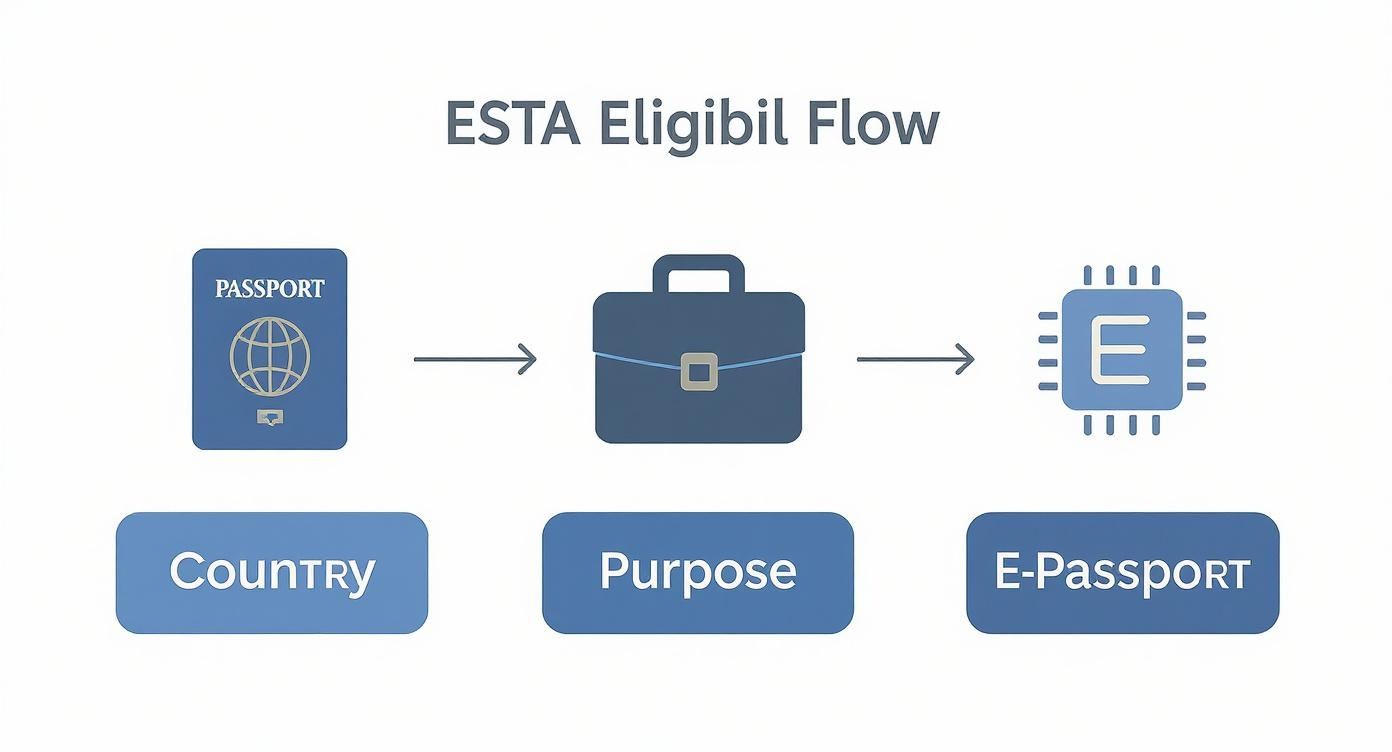
As you can see, it all boils down to three key things: your nationality, the reason for your trip, and having a modern e-passport.
The eligibility questions will dig into your background, covering topics like communicable diseases, any criminal history, and past immigration issues. It is critical to answer these questions honestly and accurately. Providing false information can lead to severe consequences, including being permanently barred from entering the United States.
Submitting and Awaiting a Decision
After you’ve filled everything out, reviewed it all for typos, and paid the fee, you're ready to submit. Once you do, you'll get a confirmation with an application number. Do not lose this number! You'll need it to check on your application's status.
The decision will come back as one of three things:
- Authorization Approved: Great news! This means you're cleared to travel to the U.S. under the Visa Waiver Program. Your approval is typically good for two years or until your passport expires, whichever happens first.
- Authorization Pending: Don't panic. This just means your application needs a closer look. It's not a denial. Just check your status again within 72 hours to get the final word.
- Travel Not Authorized: This means you aren't eligible for an ESTA. Your next step would be to apply for a standard visitor visa at a U.S. embassy or consulate.
Knowing what each of these outcomes means will help you figure out what to do next. To get a better handle on these different results, you can learn more about what your visa application status really means for your travel plans.
Pro Tip: While most ESTA applications get approved in just a few minutes, U.S. Customs and Border Protection (CBP) officially recommends applying at least 72 hours before you fly. My advice? To avoid any last-minute stress, just apply as soon as you have your travel dates locked in.
By following these steps and just being careful with the details, you can get through the ESTA process without a hitch and be one step closer to your trip to the U.S.
ESTA Fees, Validity, and Renewals
So, your ESTA application is approved. What now? Think of it less like a single-use ticket and more like a short-term travel pass with its own set of rules. Understanding the costs, how long it lasts, and what to do when it runs out is key to a smooth trip—and avoiding any nasty surprises at the airport.
First things first: the fee. There’s a mandatory government charge for every ESTA application. This fee covers the administrative cost of processing your details and also helps fund the Travel Promotion Act. While the amount can fluctuate, it's a non-negotiable part of getting your travel authorization sorted.
It's easy to assume all travel authorizations are priced similarly, but the costs can differ quite a bit from one country to another. For some perspective, you can see how another popular destination handles its fees in our guide on New Zealand visa charges.

The Two-Year ESTA Validity Period
Once you get that approval email, your ESTA is generally good for two years from the date it's issued. The only exception is if your passport expires before those two years are up—in which case, the ESTA expires with your passport.
This two-year window is one of the best things about the ESTA program. It means you can take multiple trips to the U.S. without having to go through the application process every single time. Perfect for a holiday one year and a business conference the next.
But here’s the catch you absolutely need to remember: your ESTA is electronically tethered to your passport. If your passport expires, your ESTA does too, no matter how much time was left on it. If your ESTA was approved on June 1, 2024, but your passport expires on August 1, 2025, then August 1, 2025 is the last day you can use that ESTA.
Why You Can’t Renew or Extend an ESTA
This is a common point of confusion. Unlike a driver's license or a subscription, you can't just "renew" or "extend" an ESTA. Those terms simply don't exist in the ESTA world.
You cannot renew an ESTA. Once it expires—either after two years or when your passport expires—you have to submit a brand-new application from scratch.
This means filling out the form all over again and paying the fee. It’s not about making things difficult; it’s a security measure to ensure U.S. authorities always have the most current information for every traveler arriving under the Visa Waiver Program.
When You Must Get a New ESTA
Expiration isn't the only reason you'll need a new ESTA. Certain life changes will require you to get a fresh one, even if your current authorization still has time left on it. If any of your core personal details change, it’s time to reapply.
You must submit a completely new application if:
- You get a new passport. Your ESTA is linked to a specific passport number. A new passport means the old ESTA is instantly void.
- You change your name. Whether it’s due to marriage or any other legal reason, your name must match your passport. If you change it, you need a new ESTA.
- You change your gender. Just like a name change, if the gender on your passport is updated, a new ESTA is required to reflect that.
- You change your country of citizenship. Your eligibility for the VWP is based on your citizenship, so a new passport from a different country requires a new application.
- Your eligibility answers change. Remember those "yes/no" security questions? If something happens in your life that changes one of your "no" answers to a "yes" (like a criminal conviction), you are required to reapply and answer truthfully.
How the ESTA Compares to Global Travel Systems
The U.S. ESTA wasn't created in a vacuum. It's actually a key player in a much larger, worldwide shift toward digital border control. Many of the world's top travel hotspots have launched—or are in the process of building—their own electronic travel permits, each with its own set of rules.
It’s easy to assume these systems are all the same, but that's a common mistake. They all share one primary goal: pre-screening travelers who don't need a visa. But they are absolutely not interchangeable. An approved ESTA for the U.S. won't get you into Canada, and a Canadian eTA is useless for a trip to London. Each country requires its own separate application.
ESTA vs. Canada eTA
On the surface, Canada's Electronic Travel Authorization (eTA) looks a lot like the U.S. ESTA. It’s for visa-exempt travelers arriving in Canada by air, it links directly to your passport, and it's designed for short tourism or business trips.
But when you dig a little deeper, some key differences pop up:
- How long it lasts: A Canada eTA is valid for up to five years (or until your passport expires), which is a huge jump from the ESTA’s two-year lifespan.
- The questions they ask: The Canadian eTA application is often seen as a bit more straightforward, with fewer of the in-depth security questions you’ll find on the ESTA form.
- How you arrive: This is a big one. The Canada eTA is only mandatory for air travel. If you're driving or arriving by sea, you don't need one. The ESTA, however, is required for both air and sea arrivals.
ESTA vs. UK ETA
The United Kingdom's Electronic Travel Authorisation (UK ETA) is the new kid on the block. It’s being rolled out in phases and will eventually be mandatory for all non-visa nationals visiting the UK, including travelers from the US and the EU.
The goal is the same—digitizing the border—but here’s how it’s different:
- Cost: The UK ETA's government fee is significantly lower than the ESTA's.
- Rollout: The UK is introducing its ETA on a country-by-country basis. This means you have to double-check if your nationality is on the list of those who need one before you travel.
- What it covers: Just like the ESTA, the UK ETA is for short stays covering tourism, business, study, and transit.
If you want to know more about this new requirement, our detailed guide on the UK ETA system breaks it all down for you.
While the ESTA, eTA, and ETA systems serve similar functions, their specific requirements for eligibility, validity, and application details are unique. Always verify the rules for your specific destination well before your travel date.
Global ETA System Comparison
This trend toward digital travel authorizations is only getting bigger. To help you keep track, here's a quick side-by-side look at the major systems you're likely to encounter.
| Feature | US ESTA | Canada eTA | UK ETA | EU ETIAS (Upcoming) |
|---|---|---|---|---|
| Purpose | Tourism, business, transit for 90 days | Tourism, business, transit for 6 months | Tourism, business, transit for 6 months | Tourism, business, transit for 90 days within 180 days |
| Validity | 2 years or passport expiry | 5 years or passport expiry | 2 years or passport expiry | 3 years or passport expiry |
| Government Fee | $21 USD | $7 CAD | £10 GBP | €7 EUR (for ages 18-70) |
| Required for Entry | Air and Sea | Air only | Air, Sea, and Land | Air, Sea, and Land |
| Launch Date | 2009 | 2016 | 2023 (phased) | Mid-2025 |
As you can see, while the core idea is the same, the details matter. Always check the specifics for your destination before you book anything.
The European Union is next in line with its European Travel Information and Authorization System (ETIAS). Though it's been delayed until mid-2025, it's set to cover 30 European countries in the Schengen Zone.
As you navigate these digital requirements, don't forget the practical side of travel. A little planning for things like managing leftover holiday money can make your return home that much smoother.
Your Top ESTA Questions, Answered
Even when a process seems straightforward, there are always those nagging "what if" questions. When it comes to something as important as your travel authorization, you want clear answers. We've gathered some of the most common questions travelers ask about the ESTA to clear up any confusion.
Let's dive in, so you can stop worrying about the paperwork and get back to planning your trip.
What Should I Do If My ESTA Application Is Denied?
Seeing that "Travel Not Authorized" message can be jarring, but the first thing to do is not to panic. It doesn't mean you're banned from the U.S. forever. It just means you aren't eligible to travel under the Visa Waiver Program right now.
The next step is to apply for a standard visitor visa, like a B-2 tourist visa or B-1 business visa. This process is definitely more involved—it requires a detailed application and an in-person interview at a U.S. Embassy or Consulate. Whatever you do, do not simply reapply for an ESTA and change your answers. U.S. authorities can see this as misrepresentation, which could cause much bigger immigration problems down the road.
Can I Work or Study in the US with an ESTA?
This one is a hard no. An ESTA is strictly for tourism, specific business activities, or for transiting through the U.S. It absolutely does not give you permission to get a job or enroll in a degree program.
Knowing where the line is drawn is critical.
- What's allowed? You can attend a business conference, meet with clients, or negotiate a contract.
- What's not? You cannot be paid by a U.S. company, work as a freelancer for U.S. clients, or take university classes for credit.
Sticking to these rules is non-negotiable. It keeps you in compliance with U.S. immigration law and ensures you won’t have any issues on future visits.
How Far in Advance Should I Apply?
While most ESTA applications are approved in minutes, leaving it until the last minute is a gamble you don't want to take. U.S. Customs and Border Protection (CBP) officially recommends applying at least 72 hours before you fly.
Our advice? Apply as soon as you've booked your trip. Why? Because some applications get flagged for a manual review, putting them in an "Authorization Pending" status that can take up to 72 hours to clear. Applying early gives you a safety net and saves you from that last-minute scramble and stress.
Think of it this way: Your ESTA is just as essential as your plane ticket. You wouldn't wait until the day before to book your flight, so give your travel authorization the same priority.
Do I Really Need to Print My Approved ESTA?
Officially, no. Your approved ESTA is linked electronically to your passport. When you check in for your flight or go through immigration, the officer will scan your passport and see your status digitally.
But we strongly recommend having a backup. Print out the approval confirmation or, at the very least, save a screenshot of it on your phone. Technology can be unpredictable, airline systems can have hiccups, and you just never know when you might be asked for proof. A simple printout or a digital copy can save you a lot of hassle and give you total peace of mind.
Travel authorizations can be complex, and a small mistake on your application can cause major delays. If you're planning a trip to the UK or Canada, using a trusted third-party application assistance provider like AssistEntry.com can make the process much smoother. Their experts offer full verification of your application before submission, checking for errors and ensuring compliance to increase your chances of approval.
To simplify your UK ETA application and increase your chances of approval, consider using AssistEntry—their experts guide you through the entire process, starting from just $79, which includes the government fee.
For expert assistance with your Canada eTA, visit AssistEntry's Canada eTA page for a hassle-free experience.
